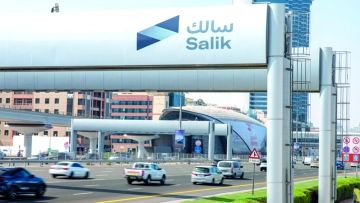
Starting tomorrow (Sunday), Salik, Dubai's toll gate system, will activate two new toll gates: one at the Business Bay Crossing and another at the South Al Safa Gate on Sheikh Zayed Road. This follows the completion of the Roads and Transport Authority (RTA) project to enhance Al Khail Road, with the gates having been installed in August this year.
The RTA emphasized that the launch of these toll gates aligns with its comprehensive strategic plan to develop an integrated network of roads, public transportation, and smart mobility systems. The initiative aims to reduce dependence on private vehicles and encourage the use of public transportation.
The decision to implement these gates is part of the authority’s efforts to improve traffic flow across Dubai’s road network. It seeks to redistribute traffic by directing it to alternative routes, such as Sheikh Mohammed bin Zayed Road, Dubai-Al Ain Road, Ras Al Khor Road, and Al Manama Road, while also promoting the use of alternative creek crossings like the Infinity Bridge and the Shindagha Tunnel. This step encourages residents and visitors to utilize less congested roads and routes.
According to studies and recommendations by international consultants, installing a gate at Business Bay Crossing and a regulatory gate at South Al Safa was necessary. The South Al Safa Gate, situated between Meydan and Umm Suqeim streets on Sheikh Zayed Road, will allow a single toll payment for vehicles passing through both Al Safa gates (north and south) within an hour. This approach aims to maintain traffic service levels, accommodate traffic volumes, and control congestion across the road network and intersections.
The Business Bay Crossing gate is expected to significantly impact traffic flow. It will redirect vehicles from Jebel Ali to Sheikh Mohammed bin Zayed Road and Emirates Road, reducing traffic on Al Khail Road by approximately 2,053 vehicles per hour (15%), on Rabat Street by 1,218 vehicles per hour (16%), and on Financial Centre Road by about 5%. Additionally, it will decrease overall travel time on the congested section of Al Khail Road between Rabat Street and Ras Al Khor Road by 20,000 hours daily in both directions.
Similarly, the operational South Al Safa Gate will reduce traffic turning right from Sheikh Zayed Road to Meydan Street by 15%, while lowering traffic volumes from Meydan and Al Safa streets onto Sheikh Zayed Road by approximately 1,070 vehicles per hour (42%). It will also decrease congestion on Sheikh Zayed Road between Financial Centre Road and Latifa bint Hamdan Street by 4%, while optimizing the use of Al Khail First Road and Al Asayel Street by up to 4%.
The RTA reiterated that toll gates are a key component of Dubai’s transport strategy, supporting the development of road infrastructure and public transportation systems. They play a vital role in redistributing traffic across the network, ensuring better utilization of road corridors, and encouraging the use of public transport, including the metro, buses, marine transport, and other flexible mobility solutions.
The authority highlighted the effectiveness of existing toll gates, noting that they have reduced the total annual travel time in Dubai by approximately six million hours, decreased traffic on Al Maktoum and Al Garhoud bridges by 26%, and cut travel time on Sheikh Zayed Road and Al Ittihad Road by 24%. Additionally, the toll system has led to a nine-million-passenger annual increase in public transportation usage.